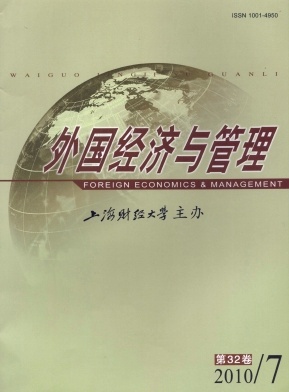基于组织管理视角的社会文化理论分析架构与研究范式述评
外国经济与管理 2010 年 第 32 卷第 07 期, 页码:17 - 23
摘要
参考文献
摘要
在人类社会历史长河中形成的各具特色的不同社会文化,是影响全球化组织管理的诸多变量中最为重要和复杂的变量之一。本研究基于组织管理视角从分析架构与研究范式入手,对社会文化理论研究文献进行了梳理,并对研究现状进行了述评,指出了现有研究所存在的问题,并对未来的研究方向进行了展望。
[1]Kluckhohn,C.Culture and behavior[A].in G Lindzey(Ed.).Handbook of social psychology[C].Cambridge,MA:Addison-Wesley,1954:931-976.
[2]Hofstede,G.Culture’s consequences:International differencesin work-related values[M].Beverly Hills,CA:Sage Publications,1980.
[3]House,R J,Hanges,P W,Javidan,M,Dorf man,P,and Gupta,V.Culture,leadership,and organizations:The GLOBEstudy of 62 societies[M].Thousand Oaks,CA:Sage Publications,2004.
[4]Kirkman,B L,Lowe,KB,and Gibson,C B.Aquarter century of culture’s consequences:Areviewof empirical researchincor-porating Hofstede’s cultural values framework[J].Journal of International Business Studies,2006,37(2):285-320.
[5]Hofstede,G,and Bond,M H.The Confucius connection:Fromcultural roots to economic growth[J].Organizational Dynamics,1988,16(4):5-21.
[6]Trompenaars,F.Riding the waves of culture:Understanding diversity in global business[M].Chicago,IL:Irwin,1993.
[7]Tsui,A S,Nifadkar,S S,and Ou,A Y.Cross-national,cross-cultural organizational behavior research:Advances,gaps,andrecommendations[J].Journal of Management,2007,33(3):426-478.
[8]Sivakumar,K,and Nakata,C.The stampede toward Hofstede’s framework:Avoidingthe sample design pit in cross-cultural re-search[J].Journal of International Business Studies,2001,32(3):555-574.
[9]Ailon,G.Mirror,mirror on the wall:Culture’s consequences in a value test of its own design[J].Academy of Management Re-view,2008,33(4):885-904.
[10]顾庆良,潘瑾,李宏,George B Graen.文化价值观对跨文化冲突的差异性影响探析[J].东华大学学报,2003,(2):7-14.
[11]Hofstede,G.Culture’s consequences:Comparing values,behaviors,institutions,and organizations across nations[M].Thou-sand Oaks,CA:Sage Publications,2001.
[12]Vandenberg,RJ,and Lance,C E.Areview and synthesis of the measurement invariance literature:Suggestions,practices,and recommendations for organizational research[J].Organizational Research Methods,2000,3(1):54-69.
[13]Parboteeah,KP,Cullen,J B,Victor,B,and Sakano,T.National culture and ethical cli mates:Acomparison of US and Japa-nese accounting firms[J].Management International Review,2005,45(4):459-481.
[14]March,J G.Parochialismin the evolution of a research community:The case of organizational studies[J].Management and Or-ganization Review,2005,1(1):5-22.
[15]Brewer,MB,and Chen,Y R.Where(who)are collectivesin collectivism?Toward conceptual clarification of individualismandcollectivism[J].Psychological Review,2007,114(1):133-151.
[16]Chao,G T,and Moon,H.The cultural mosaic:A meta-theory for understanding the complexity of culture[J].Journal of Ap-plied Psychology.2005,90(6):1 128-1 140.
[17]Marsden,D.Indigenous management[J].International Journal of Human Resource Management,1991,2(1):21-38.
[2]Hofstede,G.Culture’s consequences:International differencesin work-related values[M].Beverly Hills,CA:Sage Publications,1980.
[3]House,R J,Hanges,P W,Javidan,M,Dorf man,P,and Gupta,V.Culture,leadership,and organizations:The GLOBEstudy of 62 societies[M].Thousand Oaks,CA:Sage Publications,2004.
[4]Kirkman,B L,Lowe,KB,and Gibson,C B.Aquarter century of culture’s consequences:Areviewof empirical researchincor-porating Hofstede’s cultural values framework[J].Journal of International Business Studies,2006,37(2):285-320.
[5]Hofstede,G,and Bond,M H.The Confucius connection:Fromcultural roots to economic growth[J].Organizational Dynamics,1988,16(4):5-21.
[6]Trompenaars,F.Riding the waves of culture:Understanding diversity in global business[M].Chicago,IL:Irwin,1993.
[7]Tsui,A S,Nifadkar,S S,and Ou,A Y.Cross-national,cross-cultural organizational behavior research:Advances,gaps,andrecommendations[J].Journal of Management,2007,33(3):426-478.
[8]Sivakumar,K,and Nakata,C.The stampede toward Hofstede’s framework:Avoidingthe sample design pit in cross-cultural re-search[J].Journal of International Business Studies,2001,32(3):555-574.
[9]Ailon,G.Mirror,mirror on the wall:Culture’s consequences in a value test of its own design[J].Academy of Management Re-view,2008,33(4):885-904.
[10]顾庆良,潘瑾,李宏,George B Graen.文化价值观对跨文化冲突的差异性影响探析[J].东华大学学报,2003,(2):7-14.
[11]Hofstede,G.Culture’s consequences:Comparing values,behaviors,institutions,and organizations across nations[M].Thou-sand Oaks,CA:Sage Publications,2001.
[12]Vandenberg,RJ,and Lance,C E.Areview and synthesis of the measurement invariance literature:Suggestions,practices,and recommendations for organizational research[J].Organizational Research Methods,2000,3(1):54-69.
[13]Parboteeah,KP,Cullen,J B,Victor,B,and Sakano,T.National culture and ethical cli mates:Acomparison of US and Japa-nese accounting firms[J].Management International Review,2005,45(4):459-481.
[14]March,J G.Parochialismin the evolution of a research community:The case of organizational studies[J].Management and Or-ganization Review,2005,1(1):5-22.
[15]Brewer,MB,and Chen,Y R.Where(who)are collectivesin collectivism?Toward conceptual clarification of individualismandcollectivism[J].Psychological Review,2007,114(1):133-151.
[16]Chao,G T,and Moon,H.The cultural mosaic:A meta-theory for understanding the complexity of culture[J].Journal of Ap-plied Psychology.2005,90(6):1 128-1 140.
[17]Marsden,D.Indigenous management[J].International Journal of Human Resource Management,1991,2(1):21-38.
引用本文
戴万稳. 基于组织管理视角的社会文化理论分析架构与研究范式述评[J]. 外国经济与管理, 2010, 32(7): 17–23.
导出参考文献,格式为:
上一篇:创业学习实证研究现状探析





 5357
5357  437
437

